 W
WThe Acrocephalus warblers are small, insectivorous passerine birds belonging to the genus Acrocephalus. Formerly in the paraphyletic Old World warbler assemblage, they are now separated as the namesake of the marsh and tree warbler family Acrocephalidae. They are sometimes called marsh warblers or reed warblers, but this invites confusion with marsh warbler and reed warbler proper, especially in North America, where it is common to use lower case for bird species.
 W
WThe African reed warbler or African marsh warbler is an Old World warbler in the genus Acrocephalus. It breeds in much of Africa south of the Sahara. It is migratory within the continent, with southern breeding population moving to the tropics in the southern hemisphere's winter.
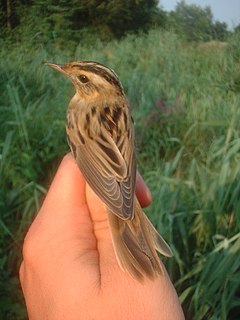 W
WThe aquatic warbler is an Old World warbler in the genus Acrocephalus. It breeds in temperate eastern Europe and western Asia, with an estimated population of 11,000-15,000 pairs. It is migratory, wintering in west Africa. After many years of uncertainty, the wintering grounds of much of the European population were finally discovered in Djoudj National Bird Sanctuary, Senegal, with between 5,000 and 10,000 birds present at this single site. Its south-westerly migration route means that it is regular on passage as far west as Great Britain and Ireland.
 W
WThe Memorandum of Understanding (MoU) concerning Conservation Measures for the Aquatic Warbler is a multilateral environmental memorandum of understanding concluded in 2003 under the auspices of the Convention on Migratory Species of Wild Animals (CMS), also known as the Bonn Convention. This MoU provides the basis for governments, NGO's and scientists to work together to save the aquatic warbler, Europe's rarest songbird. The MoU covers 22 range states. By August 2012, 16 range states and two cooperating organizations had signed the MoU.
 W
WThe Australian reed warbler is an Old World warbler in the genus Acrocephalus and is the only Acrocephalus species native to Australia. It has also been observed in Papua New Guinea and nearby islands. The name Acrocephalus refers to the peaked crown found on reed warblers in this genus and can be translated to mean "topmost head" in Greek. The species name australis is translated to mean "southern" in Latin, and refers to the species range, Australia. In its western range the Australian reed warbler is also known as "Koordjikotji" pronounced core’chee’caw’chee in the Perth area and surrounds in local Aboriginal language.
 W
WThe Basra reed warbler is a "warbler" of the genus Acrocephalus. It is an endemic breeder in East and southern Iraq, Kuwait, and Israel in extensive beds of papyrus and reeds. It is easily mistaken for the great reed warbler but is a bit smaller, has whiter under parts and has a narrower, longer and more pointed bill. It winters in East Africa. It is a very rare vagrant in Europe. The call is a gruff 'chaar', deeper than a reed warbler's.
 W
WThe black-browed reed warbler is a marsh-warbler. It was formerly included in the "Old World warbler" assemblage. The species was first described by Robert Swinhoe in 1860.
 W
WThe blunt-winged warbler is a marsh-warbler. The species was first described by Robert Swinhoe in 1870. It was formerly included in the "Old World warbler" assemblage.
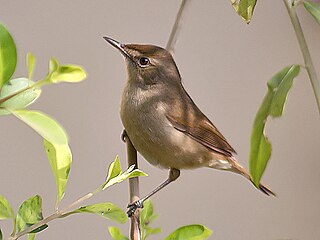 W
WBlyth's reed warbler is an Old World warbler in the genus Acrocephalus. It breeds in the Palearctic and easternmost Europe. It is migratory, wintering in Bangladesh, India and Sri Lanka. It is one of the most common winter warblers in those countries. It is a rare vagrant to western Europe.
 W
WThe bokikokiko, Kiritimati reed warbler or Christmas Island warbler is a species of warbler in the family Acrocephalidae. It is found only on Kiritimati and Washington Island (Kiribati).
 W
WThe Cape Verde warbler is an Old World warbler in the genus Acrocephalus. It is also known as the Cape Verde cane warbler or Cape Verde swamp warbler, and in Creole as tchota-de-cana, chincherote,. It breeds on Santiago, Fogo, and São Nicolau in the Cape Verde Islands. It previously bred on Brava. This species is found in well-vegetated valleys, avoiding drier areas. It nests in reedbeds, two to three eggs being laid in a suspended nest.
 W
WThe Carolinian reed warbler or Caroline Islands reed warbler is a species of Old World warbler in the family Acrocephalidae. It is found only on the Caroline Islands in Micronesia.
 W
WThe clamorous reed warbler is an Old World warbler in the genus Acrocephalus. It breeds from Egypt eastwards through Pakistan, Afghanistan and northernmost India to south China, southeast Asia and south to Australia. A. s. meridionalis is an endemic race in Sri Lanka.
 W
WThe Cook reed warbler or Cook Islands reed warbler, is a species of Old World warbler in the family Acrocephalidae. It is native to the southeastern Cook Islands. Its natural habitats are subtropical or tropical dry forests, swamps, and rural gardens. It is threatened by habitat loss.
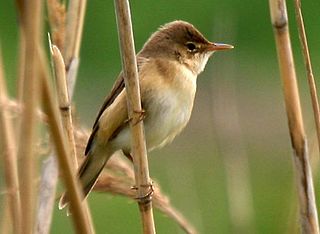 W
WThe Eurasian reed warbler, or just reed warbler, is an Old World warbler in the genus Acrocephalus. It breeds across Europe into the temperate western Palaearctic. It is migratory, wintering in sub-Saharan Africa.
 W
WGarrett's reed warbler, sometimes called Society Islands reed warbler or Forster's reed-warbler was a songbird in the genus Acrocephalus. Formerly placed in the "Old World warbler" assemblage (Sylviidae), it is now in the newly recognized marsh warbler family Acrocephalidae. It was endemic to Raiatea and Huahine in the Society Islands.
 W
WThe great reed warbler is a Eurasian passerine in the genus Acrocephalus.
 W
WThe greater swamp warbler is a species of Old World warbler in the family Acrocephalidae. It is found in Angola, Botswana, Burundi, Cameroon, Central African Republic, Chad, Republic of the Congo, Democratic Republic of the Congo, Equatorial Guinea, Gabon, Ghana, Kenya, Mali, Mauritania, Namibia, Nigeria, Rwanda, Senegal, South Sudan, Tanzania, Togo, Uganda, Zambia, and Zimbabwe. Its natural habitat is swamps.
 W
WThe Henderson reed warbler, also known as the Henderson reed-warbler, is a species of Old World warbler in the family Acrocephalidae. It is found only on Henderson Island, part of the Pitcairn Islands. Its natural habitat is subtropical or tropical dry forests. It is threatened by habitat loss.
 W
WThe large-billed reed warbler is an Old World warbler in the genus Acrocephalus. The species has been dubbed as "the world's least known bird". It was known from a single specimen collected in India in 1867 and rediscovered in the wild in Thailand in 2006. The identity of the bird caught in Thailand was established by matching DNA sequences extracted from feathers; the bird was released. After the rediscovery in the wild a second specimen was discovered amid Acrocephalus dumetorum specimens in the collections of the Natural History Museum at Tring. A breeding area was found in Afghanistan in 2009 and studies in 2011 pointed to its breeding in Kazakhstan and Tajikistan. One bird was found in the Baikka Wetland in Srimangal, Bangladesh on 7 December 2011.
 W
WThe Laysan millerbird was a subspecies of the millerbird, similar in appearance to the remaining subspecies, the Nihoa millerbird. Its dorsal side was brown, and its belly was grayish. Its name derives from its favorite food, several species of moths of the genus Agrotis commonly referred to as "millers".
 W
WThe lesser swamp warbler or Cape reed warbler is an Old World warbler in the genus Acrocephalus. It is a resident breeder in Africa from the Democratic Republic of the Congo, the Chad and Ethiopia south to South Africa. This is a common species of reedbeds in standing water.
 W
WThe Madagascar swamp warbler is a species of Old World warbler in the family Acrocephalidae. It is found only in Madagascar. Its natural habitat is swamps.
 W
WThe Manchurian reed warbler, also known as the Manchurian reed-warbler, is a species of marsh-warbler. It was formerly included in the "Old World warbler" assemblage, and was usually treated as a subspecies of the paddyfield warbler. It is found in Cambodia, China, Hong Kong, South Korea, Laos, Russia, Thailand, Vietnam, Malaysia and possibly Myanmar. Its natural habitat is swamps. It is threatened by habitat loss.
 W
WThe marsh warbler is an Old World warbler currently classified in the family Acrocephalidae. It breeds in temperate Europe and the western Palearctic and winters mainly in south east Africa. It is notable for incorporating striking imitations of a wide variety of other birds into its song.
 W
WThe millerbird is a species of Old World warbler in the family Acrocephalidae. It has two subspecies, A. f. kingi and A f. familiaris. The latter, the Laysan millerbird, became extinct sometime between 1916 and 1923. The former, the critically endangered Nihoa millerbird, remains the only race left, inhabiting the small island Nihoa in Hawaiʻi, though it has since been reintroduced to Laysan. It is the only Old World warbler to have colonised Hawaiʻi, although there is no fossil evidence that the species ever had a distribution beyond these two islands.
 W
WMoorea reed warbler is a species of songbird in the genus Acrocephalus. Formerly placed in the "Old World warbler" assemblage (Sylviidae), it is now in the newly recognized marsh warbler family Acrocephalidae. It was once considered a subspecies of the Tahiti reed warbler.
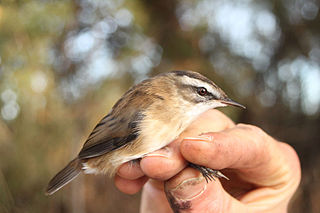 W
WThe moustached warbler is an Old World warbler in the genus Acrocephalus. It breeds in southern Europe and southern temperate Asia with a few in north-west Africa. It is partially migratory. South west European birds are resident, south east European birds winter in the Mediterranean breeding range, and the Asiatic race migrates to Arabia, India and Pakistan.
 W
WThe Nauru reed warbler, Acrocephalus rehsei, is a passerine bird endemic to the island of Nauru in the Pacific Ocean. It is one of only two native breeding land-birds on Nauru and it is the only passerine found on the island. It is related to other Micronesian reed warblers, all of which evolved from one of several radiations of the genus across the Pacific. Related warblers on nearby islands include the Carolinian reed warbler, with which the Nauru species was initially confused, and the nightingale reed warbler, which was formerly sometimes considered the same species.
 W
WThe nightingale reed warbler, or Guam reed-warbler, was a songbird endemic to Guam. It has not been seen since the 1960.
 W
WThe Nihoa millerbird is a subspecies of the millerbird. It gets its name from its preferred food, the Miller moth. The 5-inch (13 cm) long millerbird has dark, sepia-colored feathers, white belly, and dark beak. Its natural geographic range is limited to the tiny island of Nihoa in the Northwestern Hawaiian Islands, and it is hoped that birds translocated to Laysan will help to ensure the survival of the species. The Nihoa millerbird is one of the two endemic birds remaining on Nihoa, the other being the Nihoa finch.
 W
WThe northern Marquesan reed warbler is a species of Old World warbler in the family Acrocephalidae. It was formerly considered conspecific with the southern Marquesan reed warbler, and together known as the Marquesan reed warbler.
 W
WThe Oriental reed warbler is a passerine bird of eastern Asia belonging to the reed warbler genus Acrocephalus. It was formerly classified as a subspecies of the great reed warbler of the western Palearctic.
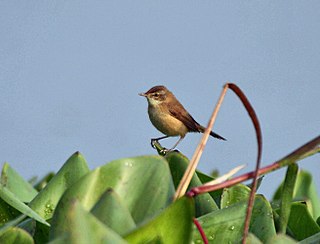 W
WThe paddyfield warbler is a species of marsh warbler. It was formerly included in the "Old World warbler" assemblage. The Manchurian reed warbler was included in A. agricola as a subspecies.
 W
WThe Pitcairn reed warbler is a songbird in the genus Acrocephalus. Formerly placed in the "Old World warbler" assemblage (Sylviidae), it is now in the newly recognized marsh-warbler family Acrocephalidae.
 W
WThe Rimatara reed warbler is a species of Old World warbler in the family Acrocephalidae. It is found only in Rimatara in French Polynesia. Its natural habitats are subtropical or tropical dry forests and swamps. Due to its limited geographic distribution, this bird is classified as critically endangered on The International Union for Conservation of Nature (IUCN) Red List of Threatened Species.
 W
WThe Saipan reed warbler is a critically endangered songbird of the Northern Mariana Islands. It is considered a subspecies of the nightingale reed warbler by some taxonomists. It occurs on two islands : Saipan and Alamagan. An estimated population of 2700 specimen was reported in 2009 on Saipan, and on Alamagan 950 specimen were reported in 2010.
 W
WThe sedge warbler is an Old World warbler in the genus Acrocephalus. It is a medium-sized warbler with a brown, streaked back and wings and a distinct pale supercilium. Sedge warblers are migratory, crossing the Sahara to get from their European and Asian breeding grounds to spend winter in Africa. The male's song is composed of random chattering phrases and can include mimicry of other species. The sedge warbler is mostly insectivorous.
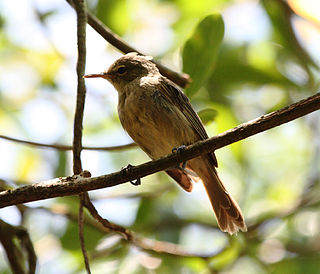 W
WThe Seychelles warbler, also known as Seychelles brush warbler, is a small songbird found on five granitic and corraline islands in the Seychelles. It is a greenish-brown bird with long legs and a long slender bill. It is primarily found in forested areas on the islands. The Seychelles warbler is a rarity in that it exhibits cooperative breeding, or alloparenting; which means that the monogamous pair is assisted by nonbreeding female helpers.
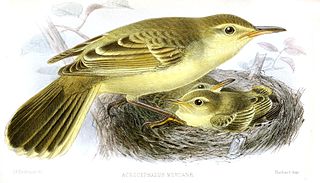 W
WThe southern Marquesan reed warbler is a species of Old World warbler in the family Acrocephalidae.
 W
WThe speckled reed warbler or streaked reed warbler is an Old World warbler in the family Acrocephalidae. The species was first described by Robert Swinhoe in 1863.
 W
WThe Tahiti reed warbler is a songbird in the genus Acrocephalus. It used to be placed in the "Old World warbler" assemblage (Sylviidae), but is now in the newly recognized marsh warbler family Acrocephalidae. It is endemic to the island of Tahiti.
 W
WThe Tuamotu reed warbler is a species of Old World warbler in the family Acrocephalidae. It is found only in French Polynesia.